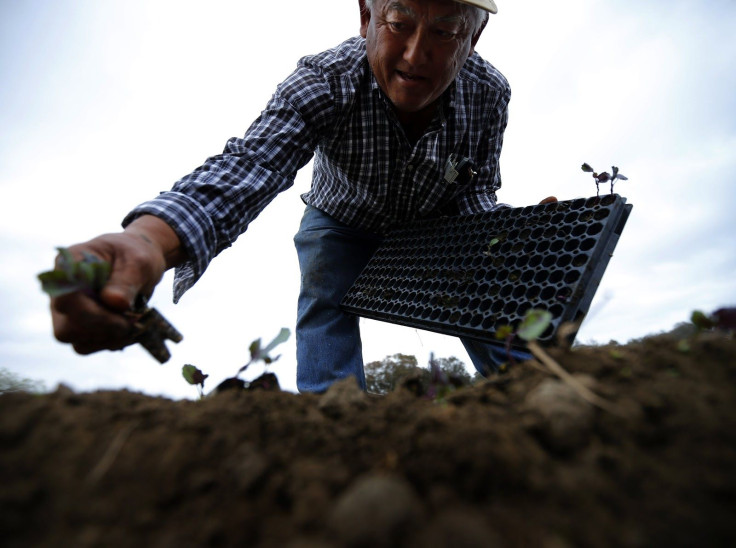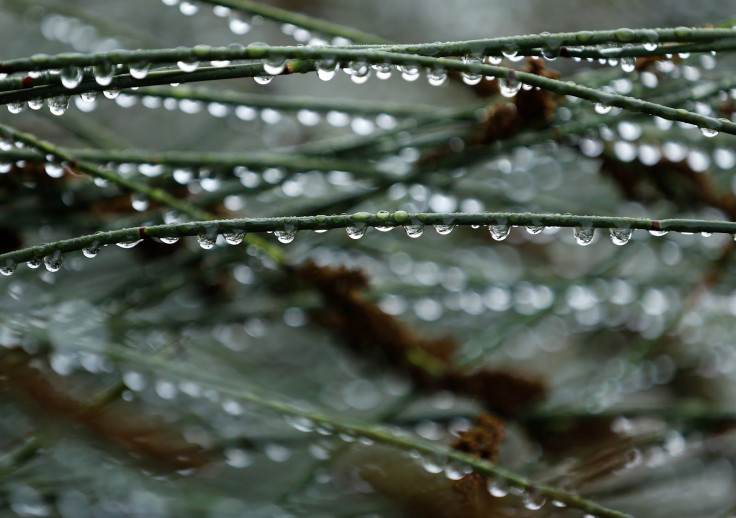Climate Change Isn't Just Impacting Crops; It's Taking A Physical And Psychological Toll On Farmers

Kathleen Finnerty is a nurse with a passion: bee farming. In almost the last 10 years, she has turned this hobby into a side business called Good Earth Honey, building up 24 hives to produce honey and selling it to diverse establishments ranging from local markets to wineries.
But the oppressive heat of the past few summers has made this job “frustrating,” Finnerty says, forcing her to find ways to help the bees work as the conditions inside the hives grow increasingly hot and exhausting.
Warmer seasons are just one of the many consequences resulting from climate change, which has both gradual (changes in temperature and precipitation rates, rises in sea levels, and higher ocean acidity) and disastrous impacts (increased flooding and droughts in various areas). Scientists have described the cause as global warming, recording a rise in Earth’s average temperature over the last century and predicting further increases between 2 and 11 degrees over the next. It has also been suggested that the effects of rising temperatures on the jet stream have caused warm air currents to push out cold air currents on different regions, creating cold snaps and the idea that colder conditions are connected to climate change. This, though, is still debated, with evidence pointing more toward growing warmer seasons than cooler ones.
Scientists, all in all, attribute the phenomenon to the same cause: the greenhouse gas effect, brought on by the burning of fossil fuels and deforestation, along with natural causes such as changes in volcanic activity and solar radiation, according to the Environmental Protection Agency. Consequently, the result in shifting temperatures has taken a toll on animals’ productivity.
“Bees will have to exit the hive to let it cool off,” Finnerty told Medical Daily. “And if you’re not in the hive, there’s no work being done or less work being done.”
Climate change, both gradual and disastrous, creates physical and financial challenges, damaging infrastructure and landscapes, and leaving people in debt over paying for repairs and expensive resources. These often bring on stress and anxiety over how to cope with the physical and financial impacts.
“If I don’t have a product, the honey product, I lose customers,” Finnerty said.
Tending To Green Pastures, Feeling Blue
Susan Clayton, a psychology professor at the College of Wooster in Ohio and a fellow for the American Psychological Association and the Society for Environmental, Population and Conservation Psychology told Medical Daily in an email that disasters are usually “more related to a traumatic stress response: anxiety, PTSD, etc., whereas responses to gradual effects are likely to affect one’s lifestyle, sense of self, and community in more subtle ways. However, the effects of things that are long-lasting are often more profound than the effects of discreet events (like disasters) from which you can recover.”
Stress and anxiety left untreated often evolve into more severe problems, including depression and post-traumatic stress disorder. These can often lead to unhealthy feelings or thoughts, such as suicide and substance abuse as forms for escape.
Like Finnerty, all types of farmers are affected by climate change. For example, produce farmers are constantly rearranging their planting schedules, while livestock and dairy farmers worry about the quality of feed available to their animals.
Matthew Russell, a fifth generation Iowa farmer says the past 10 years has made farm life a more anxious environment, as he is constantly concerned over the little time he has to address the changing conditions and its impact on the timing and quality of growing and harvesting seasons.
“Psychologically, in the last fews years, there’s a lot of anxiety that I don’t remember having 10 years ago,” Russell told Medical Daily. “In the last three or four years, there’s this tremendous anxiety around the weather because windows of time are very narrow.”
Increasing and more intense rainfall has become a huge problem for Russell, impacting the quality of his graze and making the land too muddy and wet.
“In 2010, we had a really wet spring, and the pastures weren’t grown enough. So moving the cattle, it was like the pastures were being torn up.”

Keeping Dry In The Rain
But grazing is just half the problem. This past summer was especially difficult for Russell as he watched the rain ruin the hay he spent months planting. Russell, who usually cuts his hay three times before harvest time, was unable to as ongoing rain ruined the quality and made it more difficult to cut correctly, forcing him to spend his own money on hay from other farms and markets. He eventually conceded and made the first cut in June to prevent his cutting cycle and harvest from falling off track.
“You want to cut the hay when the ground is dry and you know that there’s three or four days of rain in the forecast,” he told Medical Daily. “Those decisions are really stressful because you know going forward that your quality is going to be horrible, but if you don’t go forward with cutting the hay in June, then you mess up your crop in July.”
Cheri Liddle, a produce farmer in upstate New York, says there is only one alternative: adaptation.
“You have to adapt with items that will grow better in your area,” Liddle told Medical Daily. “You just have to adapt to your climate area and figure out what grows best in your area.”
Liddle says that the changing conditions have made her job more stressful, having to constantly change her planting schedule and costing her to lose crops “I shouldn’t have lost.”
But for Liddle, the effects of climate change also have an impact on her wallet as she often finds herself spending more and more money on supplies to help her crops grow and survive under the changing conditions. Though she is willing to pay the additional costs, it is still “frustrating,” she says.
“Just for me to feel comfortable growing tomatoes I’m going to have to spend $2000, just to plant them,” she said.
A Less Visible Problem Beyond The US
Clayton, the co-author of a 2014 report titled, "Beyond Storms and Droughts: The Psychological Impacts of Climate Change," explains that mental health problems resulting from climate change go less noticed because of many factors, including climate change denial, lack of education, politics and short-term thinking. She also points out that climate-induced stress and anxiety can be overshadowed by more noticeable causes.
“If someone experiences a mental health problem, it’s difficult to say that it’s due to climate change as opposed to some other cause,” Clayton told Medical Daily in an email, adding that these problems may be exacerbated when “the support system is just not there, or if people don’t know about it. It’s also been suggested that ideals of masculinity might inhibit male farmers from asking for help. Some studies have found that men are more affected by drought than women.”
Suicide among American farmers is high, but statistics are muddled with many being ruled as tractor or trailer accidents, which undermine the role that climate change and other factors play in these situations, according to Newsweek.
India
Psychological impacts of climate change, especially for farmers, extend well beyond U.S. borders. For example, the National Crime Records Bureau in India reported in its 2013 annual report that highest number of suicides took place among the self-employed at 38 percent. Those working in farming and agriculture had the highest number among self-employed professionals with a rate of 8.7 percent. The suicide rate in 2011 for Indian farmers was 16.3 out of 100,000, a rate 47 percent higher than the rest of the population, according to The Diplomat in 2013, which attributed climate-induced droughts, along with poverty and debt, to the cause.

Australia
Rates in Australia have "skyrocketed" because of more frequent and intense climate-induced droughts. Farmers in Queensland, one of the most affected areas by droughts, were at a higher risk of committing sucide between 2000 and 2009 in most areas of the region than non-farmers, according to the Australian Broadcasting Corporation. A 2010 study found suicide in the area was twice as high among agricultural workers and farmers, commonly self-employed professions, compared to those employed in others.
“Droughts bring financial ruin and grief at watching their starving desiccated stock that are too weak to work and need shooting,” Dr. Elizabeth Hanna, a researcher at the Australian National University and the president of the Climate and Health Alliance, told Medical Daily in an email. “Crop failures are also disheartening, and economically devastating. Watching their landscape transformed plays heavily on their heart. Especially for multi-generational farmers, losing the farm on their watch is emasculating.”
Coping With Climate Change
Clayton says the best way to address mental health problems brought on by climate change is to seek therapeutic treatment while making fixes to any physical damage incurred. She insists that communities need to help more, too.
“There are ways the [farmers] can adapt to changing conditions. They can learn about alternating crops, changing planting schedules,” she told Medical Daily, adding that communities should focus on “making sure information is available to farmers, making sure there’s ways for people to come together.”
Climate change though difficult can be overcome, according to Russell, who believes American farmers are beginning to recognize the effects of climate change and within the next few years will take on more eco-friendly practices, such as carbon neutral and carbon negative farming.
“I’m very optimistic that American farmers are going to rise to the occasion and help solve the problems associated with climate change,” Russell told Medical Daily.
Liddle is right behind him, saying hard work and determination will see her through shifting climates.
“I will always find a better growing tactic.”
Published by Medicaldaily.com



























